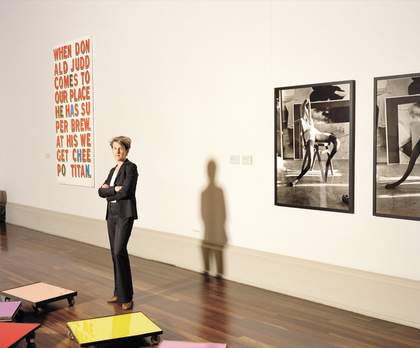
Penelope Curtis, Director, Tate Britain
© Leon Chew
Tate Britain’s Millbank Project was launched in the spring of 2011. Caruso St John Architects put forward a plan which revealed the quality of the original building while improving its facilities, its circulation and its overall articulation. We named it the Millbank Project because it focuses on the river façade as the principal gateway to the collection and opens up a new series of resonant public spaces at each level of the original building.
Just as the architects have drawn on the building’s history for their new vocabulary, so the curators have re-presented the collection in the light of its history, combining the familiar with the less familiar, the public and the private. Tate Britain’s particular strength within the Tate family is its longer history on site, and visitors will find ways in which we acknowledge this sense of continuity, while being open to change.
Tate Britain represents over 500 years of art-making in this country, and this lineage is a precious one. We aim to show it as a living tradition, in which works from the past speak to works from the present, just as artists now are interested in artists then. The conversation between old and new, whether formal or informal, deliberate or accidental, is one of our most valuable commodities.
This film file is broken and is being removed. Sorry for any inconvenience this causes.
Meet 500 years of British Art - Director's Highlights: Penelope Curtis
Looking at art is a special experience, and we aim to enhance that feeling. The architecture of our galleries is especially well-suited to viewing, and the long promenades which we can create down the west and eastern enfilades are perfect for those who wish to browse as well as those who wish to dwell. Here the collection has been hung chronologically, and on a semi-permanent basis, in recognition that many of our visitors hope and expect to find a comprehensive account of British art. A large part of the installation promotes the pleasure of looking and enables new visual conversations to be made between artworks produced in the same year. These ‘walks through time’ will eventually encircle the gallery and bring us up to the present day. It is vital that we always show works from the present, because this is the area in which we are uniquely active.
Tate Britain needs to be a laboratory as well as a showcase, and to this end we have set aside galleries within the outer circuit to act as spaces where we can present new ways of thinking about British art, whether in terms of its origins, subjects or media. Here we want to respond to outside initiatives and to new research projects, as well as showing individual artists in greater depth. These changing displays will complement the new continuity of the chronological circuit. Their greater level of interpretative focus will be mirrored in the new Archive Gallery in the undercroft.
In between the chronological promenade and the more time-specific focus displays we aim to introduce a new kind of exhibition, in which we take a trans-historical perspective to the collection, looking across time at how artists from different periods respond to similar concerns. These new projects bring together the different period expertises of our curators, joining the dots across the years.
One of the fascinations of great museums is their capacity for re-invention. Over the next few years we aim to do this both by showing more about who we were, and where we come from, but also by re-articulating those existing components, linking the present to the past, and thinking of our collection as a unified whole. This parallel journey, manifest in the way we use our architecture as well as our collection, makes up the Millbank Project.
Dr Penelope Curtis
Director, Tate Britain
